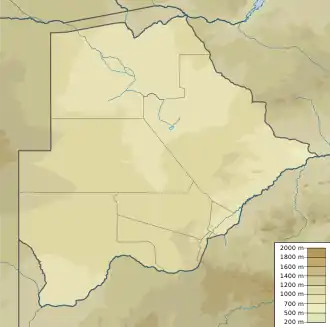Battle of Dimawe
The Battle of Dimawe was fought between several Batswana tribes and the Boers in August 1852. Under the command of Kgosi Setshele I of the Bakwena tribe, the Batswana were victorious at Dimawe Hill.[3]
| Battle of Dimawe | |||||||
|---|---|---|---|---|---|---|---|
| |||||||
| Belligerents | |||||||
| Various Batswana (Bakwena, Batlokwa, Balete, and Bahurutshe) tribal warriors |
| ||||||
| Commanders and leaders | |||||||
| Kgosi Setshele I | Andries Pretorius | ||||||
| Strength | |||||||
| 3000+ | 1000+ men[1] | ||||||
| Casualties and losses | |||||||
| 60 dead[2] | 38 dead[2] | ||||||
 Location within Botswana | |||||||
Background
Excerpt of a letter from Kgosi Setshele I to Robert Moffat
According to Paul Kruger, a chief called Moselele had committed several murders in the South African Republic, fled to Sechele I, who refused to hand him over to the Boers, saying "Who wants Moselele can come and fetch him out of my stomach". He meant to convey that Moselele was as safely hidden with him as the food which he had eaten.[3]
When the Boers arrived Sechele I send a messenger to Commandant Scholtz to say that he would do nothing to him on the morrow, as that was a Sunday, but that he would duly settle the account on the Monday. At the same time he demanded coffee and sugar, probably in return for his amiability in "letting the Boers off" for Sunday.[3] Commandant Scholtz send back word that he had coffee and sugar, but none to give away. He promised to give him pepper on Monday.[3]
Battle
The Battle began on Monday morning. During the battle Paul Kruger got injured by friendly fire ricochet.[3] And was also stuck in the chest, which tore his jacket in two.[3]
The Bakwena had knowledge of the surrounding hilltops and used them as watchtowers and hiding places.[4] When the Boers were spotted, Kgosi Setshele ordered the women and children to hide; Setshele's own pregnant wife was hidden in Mmasechele Cave several kilometers away.[4] As the Boer troops climbed the hills, Setshele's warriors rolled large stones down the hillside to crush the Boers.[4]
According to Paul Kruger: after a sharp fight, the Boers succeeded in driving them from the mountain.[3]
Afterwards the Boers raided the house of David Livingstone at the Kolobeng Mission.[2] And found a complete workshop for repairing guns, and materials of war, in breach of the Sand River Convention of 1852.[3]
David Livingstone wrote that the Boers captured hundreds of women and children before the Tswana stopped fighting.
Aftermath
After the battle, the Tswana tribes split; the Bakwena traveled to Ditlhakane and Dithubaruba while the Bahurutshe finally settled in the Kolobeng River valley around Dimawe Hill.[4]
An agreement was signed between the Boers and the Batswana in January 1853.[5] Setshele attempted to travel to Great Britain to ask for further protection from the Boers, but he only made it to Cape Town before being turned back.[4] The British did not want to make an agreement with the Batswana as that would hurt relations with the Boers.[6] However, this first failed attempt may have inspired a second successful trip to Britain in 1895 during which Kgosi Khama III, Kgosi Sebele I, and Kgosi Bathoen I asked for Botswana's incorporation into the Bechuanaland Protectorate, a separate entity from Cecil Rhodes's British South Africa Company or the South African Republic.[4] While Kgosi Setshele was en route to Britain, a group of Setshele's army encountered a small group of Boers. The Boers were so frightened that they arranged to have Setshele's children, who were captured and enslaved by a Boer commandant, returned to him.[2]
See also
Notes
Citations
- Livingstone 1857, chpt. 2.
- Livingstone 1857, chpt. 6.
- Kruger, Paul;Teixeira de Mattos. "The memoirs of Paul Kruger". library.si.edu. Retrieved 15 June 2020.
- Legodimo 2012.
- Shillington 2005.
- Beaulier 2003, p. 229.
References
- Beaulier, Scott A. (Fall 2003). "Explaining Botswana's Success: The Critical Role of Post-Colonial Policy" (PDF). Cato Journal. Cato Institute. 3 (2): 6. Archived from the original (PDF) on 8 July 2012. Retrieved 7 July 2012.CS1 maint: ref=harv (link)
- Legodimo, Chippa (22 June 2012). "How the Battle of Dimawe shaped Botswana". Arts & Culutre. Mmegi. Archived from the original on 8 July 2012. Retrieved 7 July 2012.CS1 maint: ref=harv (link)
- Leonard, Andrew (8 September 2006). "The battle of Dimawe". Salon. Archived from the original on 8 July 2012. Retrieved 8 July 2012.CS1 maint: ref=harv (link)
- Livingstone, David (1857). "Missionary Travels and Researches in South Africa" (Memoir). Archived from the original on 19 May 2007. Retrieved 8 July 2012.CS1 maint: ref=harv (link)
- Shillington, Kevin (2005). Encyclopedia of African History. CRC Press. ISBN 1-57958-453-5.CS1 maint: ref=harv (link)